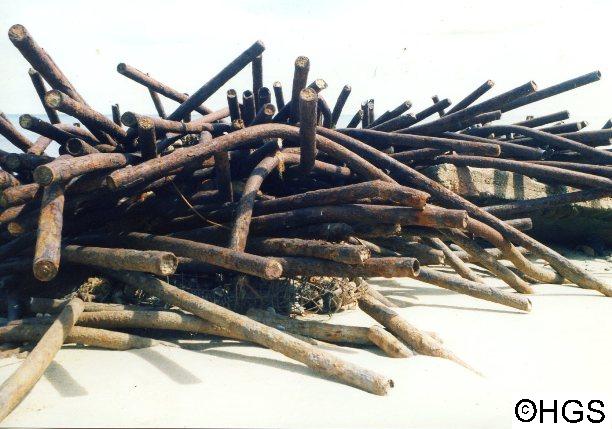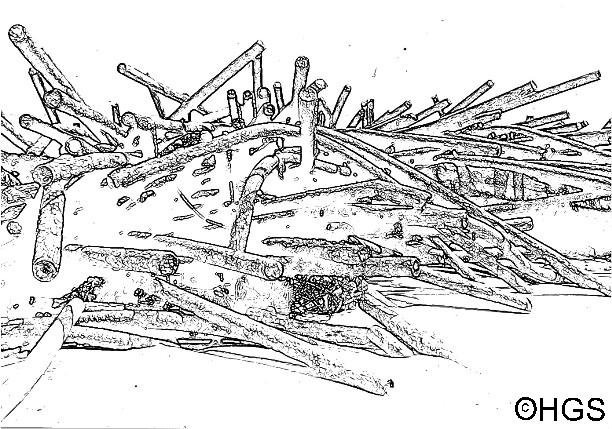
Geology and Art

Where Geology and Art meet - exploring the interface.
An illustrated talk by Mike Horne FGS for the Geology and Arts symposium at Hull School of Art and Design on 11th October 2014
abstract
The speaker will explore the interfaces between art and geology.
When my proposal for this joint meeting was accepted I started to think about the differences and similarities of geology and the arts. As the planing for the meeting continued I began to realise that each of us might have a different definition of Geology and Art. Whilst we might have an idea about the central aspects of each the definitions might be a bit fuzzy around the edges.

(copyright Mike Horne)
Is this geology?
It is a photograph of the failed sea defenses at Happisburgh in Norfolk. The defenses were put there to protect the cliffs from coastal erosion. The cliffs are a geological SSSI. These defenses are made of steel and concrete - man made materials derived from rocks and minerals, The could also be seen as a deposit of the Anthropocene - the new name for the present geological age in which one species of animal (Homo sapiens) has become a significant agent of geological change.

(copyright Mike Horne)
Is this Art?
What is it that makes the photograph I took of the sea defenses at Happisburgh artistic? Was it the was that positioned the camera to find what I though was the right angle to view the subject? was it the way that I framed the picture and focussed the camera? Is it the way I subsequently edited the scan of the photograph using software? When does a photograph become art? Or would it not be considered to be art because I am not an "artist"?
Perhaps it would be best if we avoided definitions and kept an open mind?
There might be differences between art and geology; in particular the ways that the artist and the geologist approach their topic.
There are similarities. They are both human concepts. They are both the result of our attempt to understand the world we live in. They are our attempt to impose our sense of order on our surroundings. We can collect geological specimens and works of art so that we can own a little part of our world. We even place a value on the best or rarest examples.
"with our minds we create the world"
It does seem to go back a long way into our prehistory beginning with the use of minerals in cave art.
Rudston monolith, East Yorkshire.
(copyright Mike Horne)
We still use geology and art to enhance our world - though everyday architecture and design. We still use them both ritually to mark significant moments in our lives: some of us may have been baptised in a stone font, we might have marked our betrothal and marriage with the gift of jewelry and we might mark our final resting place with a stone memorial.
So I decided to explore the interface: where geology and the arts meet.-
(copyright Mike Horne)
1 . Examples of the use of geological materials in the arts -
by Audrey Baxter
by Julia Malle
2. I think that the first geology book I bought and certainly the one I most treasure is "British Mesozoic Fossils" published by the then British Museum (Natural History). It is a glorious book full of drawings of fossils; not photographs but drawings! Those drawings somehow seemed to be three dimensional to me and captured the essence of the fossils.
When I was asked to be the scientific advisor for the geology display at the Treasure House in Beverley I was pleased to work with a local artist Nikki Abramson. Traditionally we geologists use artificial colours to illustrate our maps. Chalk is all white not green and the boulder clay is muddy. I thought it would be good to use natural colours for the local rocks. If you visit the exhibition and look closely Nikki has subtly added to that by incorporating microfossils into the chalk and erratics into the boulder clay. She also produced a series of paintings of local fossils loaned by Stuart Jones. Most impressively she took my brief of the Middle Jurassic palaeogeography to produce a map populated by dinosaurs in north Yorkshire and crinoids south of the Market Weighton "Structure".
.
(copyright N Abramson)
3. Geology inspiring artists -
Landscape -
Rocks, minerals and fossils -
copyright Mike Horne
by Nikki Abramson
4. geologists inspiring artists - examples used in the talk-
updated 6th October 2014
copyright M Horne and Hull Geological Society.